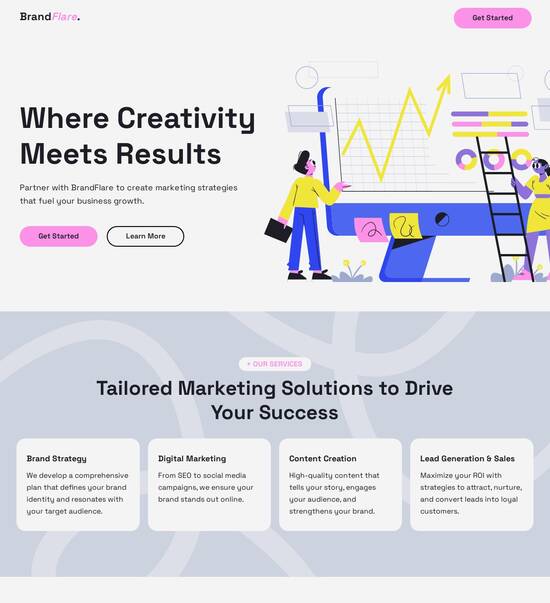
Vue.js optimized sales page templates
Explore Similar TemplatesAbout template
Make the most with Vue.js optimized sales page templates. Drive your success today.
Recommended templates

Easy to build without coding
With the intuitive drag-and-drop builder, anyone on your team can create high-converting pages without any knowledge of code or design. Make enhancements to your landing page with custom widgets using Javascript, HTML/CSS, or third-party scripts.

Multiple layouts for any industry and goal
Select from 500+ landing page layouts built to boost conversions across industry-specific scenarios. Customize them by adjusting fonts, adding images, and generating on-brand content with the AI assistant. Quickly scale with Instablocks® and Global Blocks that you can save, reuse, and update globally.

Loads fast and looks polished on any device
Every template is responsive, which means they present professionally on any device and load blazingly fast with our Thor Render Engine. You can also power them up with Google AMP technology to deliver an unparalleled mobile experience and drive higher conversions.

Robust analytics & experimentation
Get real-time updates and reporting across all your devices, showing the number of visitors, conversions, cost-per-visitor, and cost-per-lead. Launch AI-powered experiments, run A/B tests, and use heatmaps to analyze user behavior, then optimize your landing page to maximize conversions.







Easy to build without coding
With the intuitive drag-and-drop builder, anyone on your team can create high-converting pages without any knowledge of code or design. Make enhancements to your landing page with custom widgets using Javascript, HTML/CSS, or third-party scripts.
Multiple layouts for any industry and goal
Select from 500+ landing page layouts built to boost conversions across industry-specific scenarios. Customize them by adjusting fonts, adding images, and generating on-brand content with the AI assistant. Quickly scale with Instablocks® and Global Blocks that you can save, reuse, and update globally.
Loads fast and looks polished on any device
Every template is responsive, which means they present professionally on any device and load blazingly fast with our Thor Render Engine.
Robust analytics & experimentation
Get real-time updates and reporting across all your devices, showing the number of visitors, conversions, cost-per-visitor, and cost-per-lead. Launch AI-powered experiments, run A/B tests, and use heatmaps to analyze user behavior, then optimize your landing page to maximize conversions.
All the features you need to build lead-generating landing pages
Explore more featuresLearn how to build top-performing landing pages for any goal
FAQs
Leading the way in building high-performing landing pages





A step-by-step guide to mastering the landing page and CRO capabilities of Instapage
Instapage stands out as an all-in-one landing page and conversion rate optimization (CRO) platform, designed to help marketers enhance their digital campaigns effectively. With over 100 high-converting templates and powerful lead generation elements, creating optimized landing pages that capture leads efficiently has never been easier. This guide will walk you through the essential steps to leverage Instapage for maximizing your marketing ROI.
Understanding the importance of landing pages
Landing pages serve as the focal point of any digital marketing campaign. They not only capture leads but also help drive conversions and increase your overall ROI. With Instapage, you can create customized pages tailored to your audience's specific needs, setting the stage for successful marketing initiatives. The following steps illustrate how to undergo this streamlined process effectively.
Step 1: Choose the right template
Selecting the appropriate template is crucial for aligning your marketing goals with the audience's expectations. Instapage offers a vast library of over 100 ready-to-use templates. Here’s how to navigate this selection:
- Identify your campaign objective: Understand the goal of your landing page—be it lead capture, product promotion, or event registration.
- Check for responsiveness: Ensure that the selected template is mobile-friendly to accommodate all users and devices.
- Evaluate design elements: Choose a design that resonates with your brand and audience preferences.
Step 2: Optimize for conversions
Once you’ve chosen a template, the next step is to optimize it for conversions. Instapage provides built-in experimentation features and analytics tools to help you understand user behavior.
- Conduct A/B testing: Experiment with different versions of your landing page to identify what works best.
- Utilize heatmaps: Analyze detailed heatmaps to observe how visitors interact with elements on your page.
- Leverage the analytics dashboard: Monitor performance metrics to evaluate the effectiveness of your page and make necessary adjustments.
Step 3: Personalize your content
Personalization enhances user experience and boosts conversions by delivering content specific to different audience segments. Instapage allows for dynamic text replacement, which tailors your message based on specific user attributes.
- Implement dynamic text replacement: Change key text elements based on visitor data to make ads more relevant.
- Align ads with landing pages: Use AdMaps to seamlessly connect your PPC campaigns with tailored landing pages for coherence.
- Track audience metrics: Monitor performance using detailed audience-level metrics to refine your personalization efforts.
Following these steps will empower you to design and execute landing pages that not only capture leads but also drive high conversion rates, maximizing your ROI effectively.
Ready to transform your digital marketing campaigns with Instapage? Start today by exploring our range of templates and features designed for marketers like you!
Vue.js optimized sales page template: A comprehensive guide
Understanding Vue.js and its role in optimizing sales pages
Vue.js has emerged as a prominent framework in the JavaScript ecosystem, specifically designed for building interactive user interfaces. Unlike other frameworks like React and Angular, which offer different paradigms and complexities, Vue.js presents a lightweight, progressive approach that makes it accessible for developers of all skill levels. This simplicity, combined with its powerful tools, facilitates rapid development without sacrificing performance.
The core strength of Vue.js lies in its reactivity, components, and virtual DOM. Reactivity ensures that the user interface updates seamlessly in response to data changes, while the component-based architecture promotes reusability. The virtual DOM minimizes the need for direct manipulation of the actual DOM, resulting in enhanced speed and efficiency. These features contribute to building effective sales pages.
What is Vue.js?
Vue.js is an open-source framework that simplifies the building of complex web applications by allowing developers to create reusable components. While React focuses on a more functional approach and Angular employs a full-fledged MVC architecture, Vue.js strikes a balance, making it flexible and suitable for various projects.
Lightweight: Vue.js provides a simple solution without a huge overhead, which is essential for fast-loading sales pages.
Flexible: Developers can integrate Vue.js into existing projects or utilize it for building entirely new applications.
Progressive: The framework can be adopted incrementally, allowing businesses to grow without overhauling their entire tech stack.
Core features of Vue.js optimized sales page template
One of the key features of a Vue.js optimized sales page template is its component-based architecture. This allows developers to create modular and reusable segments of code, meaning that common elements such as headers, footers, and call-to-action buttons can be reused across different pages. This significantly accelerates the development process, as changes made to a single component can automatically reflect throughout the application.
Two-way data binding is another critical mechanism within Vue.js. This functionality ensures that any data changes in the application are instantly reflected in the user interface, making it easier for users to fill out forms or interact with dynamic content. Consequently, it enhances the overall user experience—vital for any sales page aiming to convert visitors.
The use of a virtual DOM in Vue.js also adds significant performance optimizations. By avoiding direct manipulation of the actual DOM for updates, Vue.js speeds up rendering, leading to quicker load times and a more responsive interface.
User interface design for sales pages
Creating engaging user interfaces is essential for sales pages, and Vue.js makes it straightforward through its component-based approach. By employing Vue components, developers can design landing pages that are not only visually appealing but also highly functional. This focus on both aesthetics and functionality translates to improved customer interactions, making the sales journey smoother.
Utilizing CSS frameworks like Bootstrap or Tailwind CSS with Vue.js components ensures that the design remains responsive and visually appealing.
Implementing UX/UI principles helps boost conversion rates by ensuring that potential customers easily navigate the sales page.
Interactive elements such as sliders, modals, and dynamic lists can be built using Vue.js, thereby enhancing user engagement.
Applications of Vue.js sales page templates
Vue.js sales page templates can be adapted for a range of applications, including multipurpose SaaS themes and e-commerce sales funnels. For SaaS products, templates can be structured to showcase functionalities and attract customers effectively. Tailoring these templates to specific industry needs allows businesses to stand out in competitive markets.
In e-commerce, Vue.js can be used to develop dynamic product showcases and checkout processes. The advantages include real-time inventory management, dynamic pricing updates, and instant user feedback capabilities, all of which add to creating a seamless shopping experience.
Building blocks of Vue.js sales page template
Understanding core Vue.js syntax and structure is crucial when developing sales page templates. Vue’s Single File Components (SFCs) allow developers to encapsulate HTML, CSS, and JavaScript within one file, simplifying the organization and management of code. This SFC structure encourages modular programming, thus making it easier to maintain and scale.
Lifecycle hooks form an integral part of Vue.js components. These hooks, such as created, mounted, and destroyed, provide developers with opportunities to run specific code at different stages of a component's lifecycle. Managing application states effectively during user interactions becomes seamless when these lifecycle hooks are used correctly.
Enhancing sale page functionality via Vue.js
Integrating APIs with Vue.js can significantly enhance sales page functionality. Using tools like Axios or the Fetch API, developers can connect to backend services, allowing for real-time data retrieval and rendering. This incorporation of data leads to more personalized user experiences, which is instrumental in gaining user trust and driving conversions.
State management becomes crucial in complex applications utilizing Vue.js. Vuex is a dedicated state management library designed for Vue applications, providing a centralized store for all components in an app. While Vuex adds structure and enables sharing of state across components, it’s essential to evaluate the pros and cons of adding such layers to your sales page templates.
Advanced techniques for performance optimization
Performance optimization can be taken to the next level through advanced techniques like lazy loading components and routes. By implementing code splitting, developers can load only the necessary components, reducing initial load times. This approach also enhances user experience, especially for those accessing sales pages from slower networks.
Utilizing server-side rendering with frameworks like Nuxt.js can greatly improve SEO performance. This technique renders pages on the server before delivering them to the client, which is better recognized by search engines. The resulting SEO benefits can lead to increased visibility and higher conversion rates, proving to be a crucial factor in the success of any sales page.
Customizing A/B testing and analytics integration
A/B testing is a powerful method for optimizing sales pages, and Vue.js supports this through its flexibility. By managing different variations in Vue templates, marketers can conduct experiments to determine which layout, text, or design drives better results. Employing libraries or plugins that complement Vue can facilitate easy A/B testing implementations.
Integrating Google Analytics into Vue.js applications allows marketers to track user behavior effectively. By implementing tracking events within Vue components, businesses can glean insights into how users interact with their sales pages, thus assessing performance metrics and informing future optimizations.
Tools and resources for web developers
To streamline the development of Vue.js sales page templates, a variety of tools and resources are available. Recommended npm packages, like vue-router for routing and vuex for state management, help enhance development workflows. Additionally, popular UI frameworks such as Vuetify and Element UI provide pre-designed components that can speed up development and ensure aesthetically pleasing designs.
The Vue.js community is robust, with numerous open-source templates accessible through platforms like GitHub. These resources not only speed up development but also provide valuable insights through successful case studies and developer experiences, fostering a collaborative environment for learning and growth.
Best practices for developing a Vue.js sales page template
Maintaining code quality and readability is paramount in Vue.js projects. By emphasizing modular programming and proper code organization, developers can make their applications easier to maintain and expand. Utilizing linters and formatters also ensures consistency across the codebase, which strengthens collaboration among team members.
Testing strategies are equally important for ensuring robustness. Unit testing with frameworks like Jest and Vue Test Utils allows developers to validate functionality at an individual component level. Additionally, incorporating end-to-end testing frameworks can help simulate user interactions, verifying that the sales page operates as intended under various conditions.
Future trends in Vue.js for sales page development
The introduction of Vue 3 has brought new features and capabilities that impact sales page creation positively. Improvements in reactivity with the Composition API allow for more efficient state management, while better TypeScript support enhances development precision. These advancements are essential as businesses strive for optimized sales pages that cater to the needs of increasingly tech-savvy consumers.
Emerging technologies, such as AI, are beginning to play a role in sales page optimization. As automation becomes more prevalent, integrating AI tools for personalization and user interaction can lead to better customer experiences. Keeping up with trends in user interaction and design will remain essential as customer expectations evolve in the web application landscape.
Case studies: Real-world impact of Vue.js on sales page effectiveness
Numerous success stories highlight the transformative potential of Vue.js for sales pages across various industries. Companies that embraced Vue.js have observed marked improvements in conversion rates and user engagement. One notable case involves a SaaS provider that updated its sales page with Vue.js components, resulting in a 30% increase in sign-ups within the first quarter post-launch.
Metrics collected pre- and post-implementation show beneficial performance improvements. By analyzing conversion rate optimizations, user engagement statistics, and customer feedback, businesses can assess the effectiveness of employing Vue.js in their sales strategies and make further modifications as needed.
Ready to skyrocket conversions?
Supercharge your ad campaigns with high-performing landing pages
Get started














